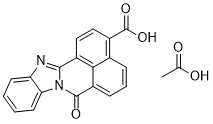This product is for research use only, not for human use. We do not sell to patients.

| Size | Price | Stock |
|---|---|---|
| 5mg | $100 | 3-6 Days |
| 10mg | $150 | 3-6 Days |
| 25mg | $245 | 3-6 Days |
| 50mg | $445 | 3-6 Days |
| 100mg | $700 | 3-6 Days |
| 250mg | $1250 | 3-6 Days |
| 500mg | $1850 | 3-6 Days |
Cat #: V2717 CAS #: 1173022-21-3 Purity ≥ 98%
Description: STO-609 acetate is a novel, potent, specific and cell-permeable inhibitor of the Ca2+/Calmodulin-dependent protein kinase kinase(CaM-KK) that inhibits the activities of recombinant CaM-KKα and CaM-KKβ isoforms with Ki values of 80 and 15 ng/ml, respectively, it also inhibits their autophosphorylation activities. STO-609 inhibits the activities of recombinant CaM-KK alpha and CaM-KK beta isoforms, with K(i) values of 80 and 15 ng/ml, respectively, and also inhibits their autophosphorylation activities. Comparison of the inhibitory potency of the compound against various protein kinases revealed that STO-609 is highly selective for CaM-KK without any significant effect on the downstream CaM kinases (CaM-KI and -IV), and the IC(50) value of the compound against CaM-KII is approximately 10 microg/ml. STO-609 inhibits constitutively active CaM-KK alpha (glutathione S-transferase (GST)-CaM-KK-(84-434)) as well as the wild-type enzyme.
Publications Citing InvivoChem Products
Product Promise

- Physicochemical and Storage Information
- Protocol
- Related Biological Data
- Stock Solution Preparation
- Quality Control Documentation
| Molecular Weight (MW) | 374.35 |
|---|---|
| Molecular Formula | C21H14N2O5 |
| CAS No. | 1173022-21-3 |
| Storage | -20℃ for 3 years in powder form |
| -80℃ for 2 years in solvent | |
| Solubility In Vitro | DMSO: 5.6 mg/mL |
| Water: <1 mg/mL | |
| Ethanol: <1 mg/mL | |
| Synonyms | STO-609 acetate; STO 609 acetate; STO609 acetate |
| Protocol | In Vitro | In vitro activity: STO-609 inhibits the activities of recombinant CaM-KKα and CaM-KKβ isoforms, with Ki values of 80 and 15 ng/ml, respectively, and also inhibits their autophosphorylation activities. STO-609 is highly selective for CaM-KK without any significant effect on the downstream CaM kinases (CaM-KI and -IV). In transfected HeLa cells, STO-609 suppresses the Ca2+-induced activation of CaM-KIV in a dose-dependent manner. STO-609 can permeate cells and is a competitive inhibitor of ATP. Kinase Assay: CaM-KI (2.5 μg/mL), CaM-KII (0.75 μg/mL), CaM-KIV (9 μg/mL), and mLCK (0.6 μg/mL) are incubated with 40 μM syntide-2 or 50 μM mLC peptide (for mLCK) at 30 °C for 5 min in a solution (25 μL) containing 50 mM HEPES (pH 7.5), 10 mM Mg(Ac)2, 1 mM DTT, 50 μM [γ-32P]ATP (4500 cpm/pmol) with various concentrations of STO-609 (0–10 μg/mL)in Me2SO at a final concentration of 4%) in the presence of 1 mM CaCl2, 2 μM CaM. Protein kinase activity is measured by the phosphocellulose filter method. Specific activities of CaM-KI, CaM-KII, CaM-KIV, and mLCK in the absence of STO-609 are calculated. STO-609 is bound in the ATP-binding pocket of the CaMKKβ KD. The inhibition mechanism of STO-609 is ATP-competitive. Cell Assay: HeLa cells were maintained in Dulbecco's modified Eagle's medium containing 10% fetal bovine serum. Cells were subcultured in 6-cm dishes 12 h before transfection. The cells were then transferred to serum-free medium and treated with a mixture of either 3 g of pME18s plasmid DNA or 3 g of HA(hemagglutinin-tagged)-CaM-KIV and 20 μg of LipofectAMINE reagent in 2.5 ml of medium. After 20 h of incubation, the cells were further cultured in serum-free medium for 6 h in either the absence or presence of various concentrations of STO-609(0.01-10 μg/ml in Me2SO at a final concentration of 0.5%) and then treated with or without 1 μM ionomycin for 5 min. Stimulation was terminated by the addition of 1 ml of lysis buffer, 2 mM EDTA, 2 mM EGTA, 1% Nonidet P-40, 10% glycerol, 0.2 mM phenylmethylsulfonyl fluoride, 10 mg/liter leupeptin, 10 mg/liter trypsin inhibitor, and 1 μM microcystin LR), and the cells were lysed for 30min on ice. The cell extract was collected and centrifuged at 15,000×g for 15 min, the supernatant was precleared with 40 μl of Protein G-Sepharose for 2h at 4 °C, and the supernatant was mixed with 4 g of anti-HA antibody for 3h. 40 μl of Protein G-Sepharose was then applied to the extract and incubated overnight. The immunoprecipitated resin was washed three times with 1 ml of the lysis buffer and then washed with 1 ml of kinase buffer. Protein G-Sepharose with immunoprecipitated HA-CaM-KIV was subjected to the protein kinase assay in the presence of 1 mM EGTA using syntide-2 as a substrate. |
|---|---|---|
| In Vivo | In vivo administration of STO-609 results in increased osteoblasts and diminished osteoclasts, conferring significant protection from ovariectomy (OVX)-induced osteoporosis in adult mice. ICV administration of STO-609 in vivo did not affect the counterregulatory responses to neuroglucopenia and AMPK activation induced by glucopenia. | |
| Animal model | WT, Camkk2−/− and Camk4−/− mice (all in C57BL/6 background) |
| Solvent volume to be added | Mass (the weight of a compound) | |||
|---|---|---|---|---|
| Mother liquor concentration | 1mg | 5mg | 10mg | 20mg |
| 1mM | 2.6713 mL | 13.3565 mL | 26.7130 mL | 53.4259 mL |
| 5mM | 0.5343 mL | 2.6713 mL | 5.3426 mL | 10.6852 mL |
| 10mM | 0.2671 mL | 1.3356 mL | 2.6713 mL | 5.3426 mL |
| 20mM | 0.1336 mL | 0.6678 mL | 1.3356 mL | 2.6713 mL |
This equation is commonly abbreviated as: C1 V1 = C2 V2
- (1) Please be sure that the solution is clear before the addition of next solvent. Dissolution methods like vortex, ultrasound or warming and heat may be used to aid dissolving.
- (2) Be sure to add the solvent(s) in order.




































